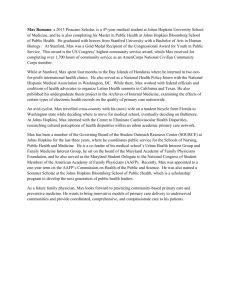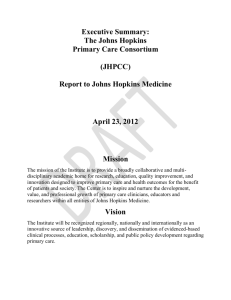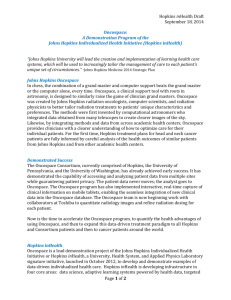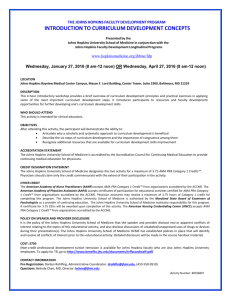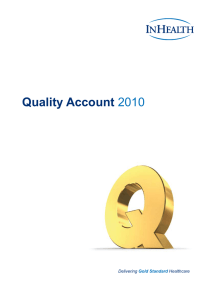Johns Hopkins Individualized Health Initiative Frequently Asked
advertisement
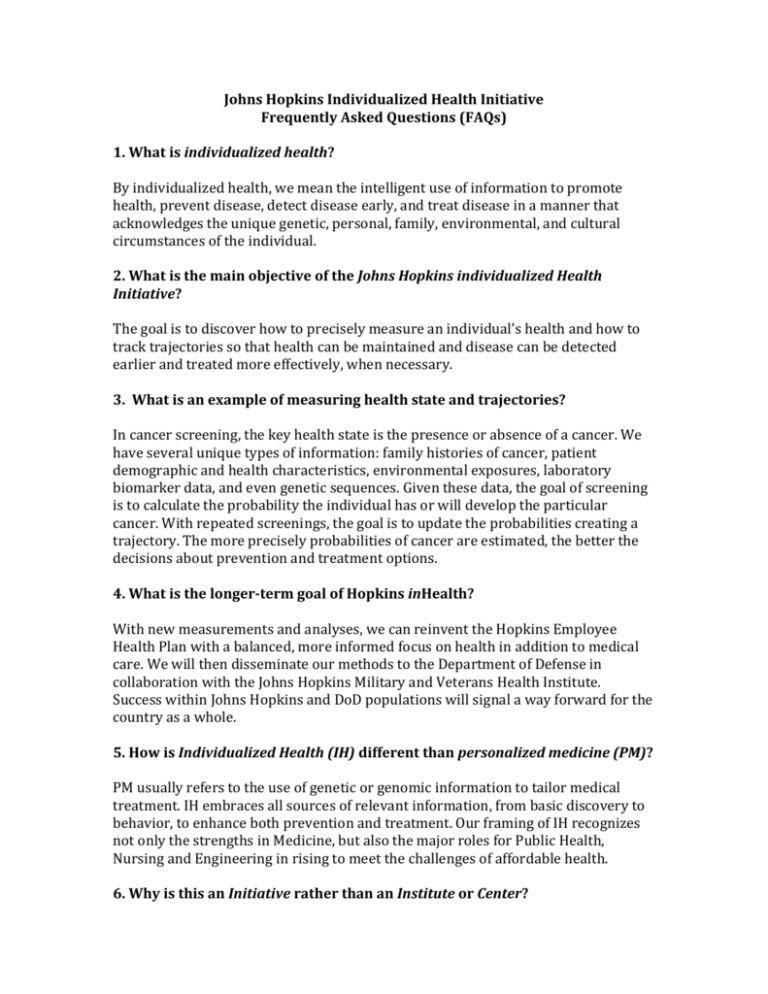
Johns Hopkins Individualized Health Initiative Frequently Asked Questions (FAQs) 1. What is individualized health? By individualized health, we mean the intelligent use of information to promote health, prevent disease, detect disease early, and treat disease in a manner that acknowledges the unique genetic, personal, family, environmental, and cultural circumstances of the individual. 2. What is the main objective of the Johns Hopkins individualized Health Initiative? The goal is to discover how to precisely measure an individual’s health and how to track trajectories so that health can be maintained and disease can be detected earlier and treated more effectively, when necessary. 3. What is an example of measuring health state and trajectories? In cancer screening, the key health state is the presence or absence of a cancer. We have several unique types of information: family histories of cancer, patient demographic and health characteristics, environmental exposures, laboratory biomarker data, and even genetic sequences. Given these data, the goal of screening is to calculate the probability the individual has or will develop the particular cancer. With repeated screenings, the goal is to update the probabilities creating a trajectory. The more precisely probabilities of cancer are estimated, the better the decisions about prevention and treatment options. 4. What is the longer-term goal of Hopkins inHealth? With new measurements and analyses, we can reinvent the Hopkins Employee Health Plan with a balanced, more informed focus on health in addition to medical care. We will then disseminate our methods to the Department of Defense in collaboration with the Johns Hopkins Military and Veterans Health Institute. Success within Johns Hopkins and DoD populations will signal a way forward for the country as a whole. 5. How is Individualized Health (IH) different than personalized medicine (PM)? PM usually refers to the use of genetic or genomic information to tailor medical treatment. IH embraces all sources of relevant information, from basic discovery to behavior, to enhance both prevention and treatment. Our framing of IH recognizes not only the strengths in Medicine, but also the major roles for Public Health, Nursing and Engineering in rising to meet the challenges of affordable health. 6. Why is this an Initiative rather than an Institute or Center? Johns Hopkins is already the home to many successful centers, institutes, and departments working to improve individual and population health, for example the Armstrong Institute for Patient Safety and Quality, the Center for Population Health Information Technology, the Center for Population Health and Health Disparities, and the Center for Health Services and Outcomes Research, to name a few. Hopkins inHealth has the goal of making each of these more successful by improving our capacity to use information, by investing in people and shared infrastructure, and by attracting major donors and funders to invest in their common objectives. 7. What are the key components of the Initiative? Hopkins inHealth comprises four cores: Information technology for health will define health state and develop tracking systems. We intend to partner with a technology firm to develop a new platform for inHeath IT applications or “inHealth apps” that improve decision making for population and patient health. Learning communities for health will develop the bioethics, biostatistics, and clinical research methods to combine information from clinical research and care over time and across populations so that every Johns Hopkins employee or patient benefits from what is learned by all who come before and contributes to knowledge for all who follow. Better sources of health information will fuel state-of-the art population and clinical research, as well. Bioscience discovery to advance health will make targeted investments in basic science to fill in key gaps in our understanding of health and disease mechanisms and to improve critical health measurements. A key example is a non-invasive genomics or epigenomics test for cancer cells. Organizational models for affordable healthcare. Johns Hopkins HealthCare currently provides capitated medical care for 275,000 persons. The inHealth methods and products will be developed in partnership with JHHC and implemented there first. The goal is to demonstrate their utility in supporting affordable health. In addition, there are four initial case studies selected to represent the breadth of potential projects: cancer screening, obesity/diabetes management, neuroimaging and autoimmune disease diagnosis and treatment. 8. Why Johns Hopkins? Johns Hopkins is uniquely qualified to discover, implement, and disseminate information-based solutions that address key issues in the American health crisis. The Johns Hopkins Schools of Public Health, Medicine and Nursing are among the best academic health institutions in the world. Faculty in Johns Hopkins’ schools of Engineering and Arts and Sciences, and scientists at the Applied Physics Laboratory bring world-class expertise in statistics, applied mathematics, computer science, and systems engineering. Johns Hopkins has a strong tradition of entrepreneurial faculty seeking solutions to societal problems. The Johns Hopkins Health System, rated best in the United States for 18 years running, is poised to innovate by testing information-driven, individualized health tools. It has 275,000 health-plan members with whom health decision-support tools can be implemented and continuously improved. The Applied Physics Laboratory (APL) is an internationally renowned leader in designing and engineering information-systems to solve complex problems. APL will disseminate Johns Hopkins inHealth advances to the Department of Defense, for whom it serves as a trusted agent, expanding the utility of Johns Hopkins discoveries to the country as a whole. 9. Will the Initiative depend upon the new EPIC system? EPIC is a transactional system that acquires and manages patient information. inHealth Initiative will depend upon and add value to the EPIC project by focusing on how clinicians USE the EPIC or other data to make challenging medical decisions that depend on precise assessments of health state and trajectory. 10. How will the Initiative benefit Johns Hopkins Investigators? The goal is to enhance the significance of existing programs and centers, by telling the collective story of our work at Johns Hopkins to improve the American health system. inHealth also plans to attract resources to invest in key infrastructure such as high performance computing, biotechnology, software systems development, applications platforms, informed consent protocols, statistical designs, and laboratory-based discoveries and measurements that facilitate JH research. Finally, a key goal is to raise $400 million over the 10 years of the upcoming campaign, spending no more than 6% on inHealth itself. 11. How will inHealth benefit the patient? inHealth will enable both patient and doctor to better understand the patient’s health state and its trajectory. By focusing on the key information and by representing it simply in graphic designs that motivate action, the patient and doctor will make better-informed health decisions. Approximately 25% of Medicare expenditure goes toward “preference-sensitive” care, whereby patients are confronted with different treatment options with different outcomes.1 For example, in prostate cancer treatment, watchful waiting and surgery are options that depend critically on patient preferences. Where information is presented clearly to patients 1 Wennberg E. 2010. Tracking medicine. Oxford University Press, New York, page 9. and their physicians, they are empowered to make better decisions to improve health at more affordable costs. 12. How does the experience of many prior patients inform an individual’s treatment decision? In the inHealth approach, the individual patient contributes to the wider community as an anonymous source of medical data and information. When data from thousands of similar individuals are compiled and analyzed, the results provide substantial knowledge about what is likely to work best for the particular patient at hand. Because data is collected and shared systematically, and because decision support tools are scientifically more rigorous, the quality of decision-making improves. 13. Are there opportunities to commercialize the intellectual property or know how developed through the inHealth initiative? Absolutely! A key goal of inHealth is to use information technologies to more widely disseminate the IP and know how of Johns Hopkins faculty. We anticipate the development of software, screening protocols, novel measurements and assays and other IP. We also envision partnerships with technology companies or other health care providers to foster more individualized health approaches. inHealth is interested to work with commercialization experts at JHU Technology Transfer, JHHS HealthCare Solutions as well as with external venture capital groups as appropriate to make it easier for Johns Hopkins faculty to disseminate their inHealth discoveries.
